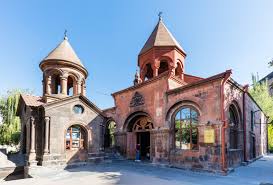The world we live in today is, for the most part, a wonderful place.
We have everything we could ever need at the touch of a fingertip. Disease and illness across the globe are at an all-time low, and less people are living in poverty than ever before.
However, despite these global improvements, there are many countries that suffer in silence.
Countries like Armenia, for example.
Sharing its borders with Turkey, Georgia, and Azerbaijan, Armenia is a small country that is renowned for its strong will and unique culture. Full to the brim with amazing architecture, strong and happy people, and beautiful scenery, it is an incredible place.
We should also note that Armenia was one of earliest Christian civilisations on the planet. As a result, it is the home to several religious sites that should be recognised by people around the world.
But instead, they are facing their end.
The history of Armenia is full of bloodshed. Over the last thousand years it was forced to face down countless invasions, before eventually succumbing to the Soviet Union in the 1900s. Then, after finally gaining independence in 1991, it was quickly drawn into a civil war with Azerbaijan.
Now its incredible Christian history – and its many religious sites – are facing destruction.
Including the amazing Surp Astvatsatsin Vank Church.
Surp Astvatsatsin Vank Church
The Surp Astvatsatsin Church is the oldest surviving church in the capital of Armenia, Yerevan.
Located within the beautiful Shahar District of Old Yerevan, it sits where the tomb and Chapel of Ananias the Apostle was previously located – which is why it is revered as one of the most famous sanctuaries in Europe.
Early in the 16th century, the monk “Movses Syunetsi” built a monastery complex with the financial support the local people of Yerevan. This complex was comprised of the amazing Surp Astvatsatsin church and chapel of Saint Anania, both of which were enclosed within fortified walls.
Within this haven a monastic school was opened to repay the residents of Yerevan for their support, where local children were taught by the resident priests of the monastery.
The construction of this amazing monastery took place during the reign of Philip the 1st of Armenia, between the years of 1632 and 1635. However, the building did not last long, and was destroyed in its entirety during a large earthquake that occurred in 1679.
Fortunately, the stoic nature of the Armenia people would not be dampened, and the church was rebuilt in full in 1694 – largely due to a significant donation from one of the most well-respected residents of Yerevan, a man by the name of “Khoja Panos”.
Once again, it became a hub of activity for the people of Yerevan. It was a place of prayer, learning, of joy, and of sorrow – it was a pillar of the community.
Seeing the church in modern day is an incredible experience. With a three-nave basilica design, and without a common dome, it is a structure that takes your breath away.
Inside, the eastern side of the prayer hall acts as the main altar, with vestries located at both the northern and southern corners. Architecturally, the interior and exterior features of the church are characterized by a striking simplicity – while the three-vaulted porch in the western part of the church contains decorative columns that create a sense of liveliness, adding to the design.
And if you take a close look at the external walls you will see several beautifully carved khachkars that date all the way back to the 17th century.
Amazing is an understatement.
The Fall and Rise of Surp Astvatsatsin Church
Between the 17th and 19th centuries, the Surp Astvatsatsin Church served its people well. It was a place of worship and celebration, of weddings and funerals, of learning, and of course, a place of prayer.
It was often considered the spiritual home of the Armenian people – and deservedly so.
However, after the soviets took over Armenia in the early 1900s, it lost its purpose. It was used for a variety of different reasons, including a storage house, a community home, and even a school for children.
Finally, after serving various purposes during the Soviet rule, Surp Astvatsatsin Church was finally returned to the Armenian Apostolic Church during the 1970s – when it was entirely renovated to reverse some of the soviet damage.
The decayed and falling parts of the walls and roofs were repaired and restored, a choir was added, and a new house was built for the local priests.
Life was breathed back into this amazing building.
But they are not through the woods yet.
A Modern Threat
After nearly a century of pain and destruction, it finally looked as if the Armenian people would get some time to rebuild.
But they were not so lucky.
Thirty years after escaping the punishing reign of the Soviet Union, Armenia was forced into the “care” of the Republic of Azerbaijan –as a result, their history, and the amazing religious monuments within, are at risk of destruction.
If this is let unnoticed you can be sure that Surp Astvatsatsin Church will once again be destroyed.
Armenia has repeatedly surprised the world with is strength and stoicism in the face of danger. But many believe the current threat to their culture, and their way of life, will be unavoidable if they must face it alone.
Which is why we want it to be supported by the help and faith of the world.
Supported by your help, and your faith.
